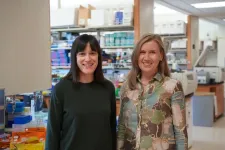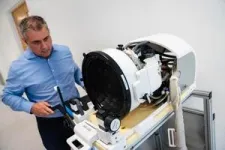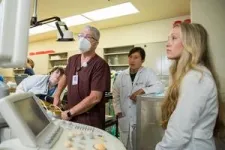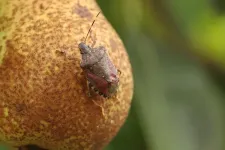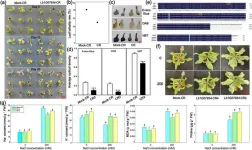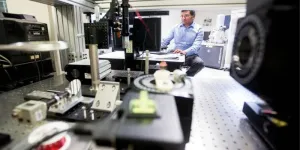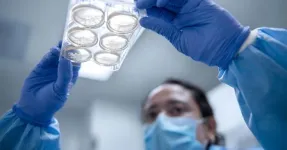(Press-News.org) UCLA scientists have identified a protein that plays a critical role in regulating human blood stem cell self-renewal by helping them sense and interpret signals from their environment.
The study, published in Nature, brings researchers one step closer to developing methods to expand blood stem cells in a lab dish, which could make life-saving transplants of these cells more available and increase the safety of blood stem cell-based treatments, such as gene therapies.
Blood stem cells, also known as hematopoietic stem cells, have the ability to make copies of themselves via a process called self-renewal, and can differentiate to produce all the blood and immune cells found in the body. For decades, transplants of these cells have been used as life-saving treatments for blood cancers such as leukemia and various other blood and immune disorders.
However, blood stem cell transplants have significant limitations. Finding a compatible donor can be difficult, particularly for people of non-European ancestry, and the number of stem cells available for transplant can be too low to safely treat a person’s disease.
These limitations persist because blood stem cells that have been removed from the body and placed in a lab dish quickly lose their ability to self-renew. After decades of research, scientists have come achingly close to solving this problem.
“We’ve figured out how to produce cells that look just like blood stem cells and have all of their hallmarks, but when these cells are used in transplants, many of them still don’t work; there’s something missing,” said Dr. Hanna Mikkola, senior author of the new study and a member of the Eli and Edythe Broad Center of Regenerative Medicine and Stem Cell Research at UCLA.
To pinpoint the missing piece that prevents these blood stem cell-like cells from being fully functional, Julia Aguade Gorgorio, the paper’s first and co-corresponding author, analyzed sequencing data to identify genes that are silenced when blood stem cells are placed in a lab dish. One such gene, MYCT1, which encodes a protein by the same name, stood out as being essential to these cells’ self-renewal capacity.
They found that MYCT1 regulates a process called endocytosis, which plays a key role in how blood stem cells take in the signals from their environment that tell them when to self-renew, when to differentiate and when to be quiet.
“When cells perceive a signal, they have to internalize it and process it; MYCT1 controls how fast and how efficiently blood stem cells perceive these signals,” said Aguade Gorgorio, an assistant project scientist in the Mikkola lab. “Without this protein, the signals from the cells’ environment turn from whispers into screams and the cells become stressed out and dysregulated.”
The researchers compare MYCT1 to the sensors in modern cars that monitor all nearby activity and selectively relay the most crucial information to drivers at the right time, aiding decisions like when to safely turn or change lanes. Without MYCT1, blood stem cells resemble anxious drivers who, used to relying on these sensors, suddenly find themselves lost without their guidance.
Next, the researchers used a viral vector to reintroduce MYCT1 to see if its presence could restore blood stem cell self-renewal in a lab dish. Restoration of MYCT1, they found, not only made the blood stem cells less stressed and enabled them to self-renew in culture but also allowed these expanded cells to function effectively after being transplanted into mouse models.
As a next step, the team will investigate why the silencing of the MYCT1 gene occurs, and then, how to prevent this silencing without the use of a viral vector, which would be safer for use in a clinical setting.
“If we can find a way to maintain MYCT1 expression in blood stem cells in culture and after transplant, it will open the door to maximize all these other remarkable advances in the field,” said Mikkola, who is a professor of molecular, cell and developmental biology in the UCLA College and a member of the UCLA Health Jonsson Comprehensive Cancer Center. “This would not only make blood stem cell transplants more accessible and effective but also improve the safety and affordability of gene therapies that utilize these cells.”
This work was supported by the National Institutes of Health, the Swiss National Science Foundation, the European Molecular Biology Organization, the UCLA Jonsson Cancer Center Foundation, the James B. Pendleton Charitable Trust, the McCarthy Family Foundation, the California Institute for Regenerative Medicine, the UCLA AIDS Institute, the Board of Governors Regenerative Medicine Institute at Cedars-Sinai Medical Center, the Royal Society, the Wellcome Trust and the UCLA Broad Stem Cell Research Center Stem Cell Training Program.
END
Scientists identify ‘missing piece’ required for blood stem cell self-renewal
Study could help make life-saving stem cell transplants more available
2024-06-05
ELSE PRESS RELEASES FROM THIS DATE:
Father's diet before conception influences children's health
2024-06-05
Dr. Raffaele Teperino, head of the "Environmental Epigenetics" research group at Helmholtz Munich, along with his research team, has examined the impact of paternal diet on children's health – specifically, the influence of diet before conception. The researchers focused on special small RNA molecules in sperm, known as mitochondrial tRNA fragments (mt-tsRNAs, see background). These RNAs play a key role in the inheritance of health traits by regulating gene expression.
For their study, the researchers used data from the LIFE Child cohort, which includes information from over 3,000 families. The analyses showed ...
Fountain of youth for plants: E3 ligase's role in leaf longevity
2024-06-05
A new study uncovers the intricate molecular mechanisms that regulate leaf senescence in apple plants, focusing on the crucial role of the E3 ligase enzyme, MdPUB23, and its interaction with the ABI5 protein. This research provides valuable insights into how plants manage stress responses and maintain growth, offering potential applications in improving crop yield and stress resistance.
Leaf senescence is a vital phase in the life cycle of plants, impacting overall plant health and yield. Abscisic acid (ABA) ...
Drones and AI harnessed to monitor invasive stink bugs
2024-06-05
Researchers in Italy have unveiled the first successful application of commercial drones combined with artificial intelligence (AI) to monitor the invasive agricultural pest, Halyomorpha halys, commonly known as the brown marmorated stink bug. This research, published in the SCI journal Pest Management Science, marks a significant advancement in the use of unmanned aerial vehicles (UAVs) for automated monitoring of invasive species.
Halyomorpha halys is notorious for its extensive damage to orchard crops across North America and southern Europe. In Italy, this invasive pest caused an ...
Unlocking salt resistance: sea lavender's genetic secret revealed
2024-06-05
Recent research has uncovered the genetic mechanisms behind sea lavender's (Limonium bicolor) salt tolerance by studying basic helix–loop–helix (bHLH) transcription factors. Identifying 187 bHLH genes, the study highlights their roles in salt gland development and stress responses. CRISPR-Cas9 validation demonstrated specific bHLH genes' critical role in enhancing salt tolerance, paving the way for future applications in crop improvement and saline soil management.
Basic helix–loop–helix (bHLH) transcription factors are essential for various plant processes, including ...
Six UTA faculty receive prestigious CAREER grants
2024-06-05
Six faculty members from The University of Texas at Arlington received more than $3.23 million in awards as part of the National Science Foundation’s (NSF) Faculty Early Career Development Program. Called CAREER, these awards are considered the NSF’s most prestigious for early-career faculty and are given to those who have the potential to serve as academic role models in research and education.
Between 2017 and 2022, UTA received nine CAREER awards; in 2023, it received six. Vice President of research and innovation Kate C. Miller called this “a true testament to the world-class research teams we’re assembling here in Arlington.”
“CAREER ...
Brain overgrowth dictates autism severity, new research suggests
2024-06-05
Some children with autism experience profound, lifelong difficulties like developmental delay, social struggles and even the inability to speak. Others experience more mild symptoms that improve with time.
The disparity in outcomes has been a mystery to scientists, until now. A new study, published in Molecular Autism by researchers at University of California San Diego, is the first to shed light on the matter. Among its findings: The biological basis for these two subtypes of autism develops in utero.
Researchers ...
MD Anderson Research Highlights for June 5, 2024
2024-06-05
HOUSTON ― The University of Texas MD Anderson Cancer Center’s Research Highlights showcases the latest breakthroughs in cancer care, research and prevention. These advances are made possible through seamless collaboration between MD Anderson’s world-leading clinicians and scientists, bringing discoveries from the lab to the clinic and back.
Recent developments at MD Anderson offer insights into a lower-intensity therapy combination for older patients with acute myeloid leukemia (AML), a novel T cell therapy for patients with bone marrow failure syndromes, a proof-of-concept study using MRI to detect metabolic changes inside tumors, a molecular target to overcome treatment resistance ...
New study finds many of the world’s most threatened species lack evidence of sufficient conservation efforts
2024-06-05
-With images-
A new study has revealed alarming gaps in the implementation of conservation interventions for thousands of the world's most threatened species.
The research, published in the journal Nature, shows that most terrestrial plant and animal species at risk of extinction from threats like habitat loss, over-exploitation for trade, and invasive species are not receiving the appropriate types of conservation efforts needed to protect them.
The study findings suggest that there is a serious mismatch between the ...
BU study: Black-specific incarceration rates are associated with Black firearm homicide rates
2024-06-05
(Boston)—Firearm-related injury remains a significant burden in the U.S. with more than 45,000 people dying from these injuries in 2020. Suicides continue to account for the majority of all gun deaths. The number of homicides due to gun violence decreased between 1990 and 2010, but the last decade has seen an uptick. Homicides now make up 45% of all gun-related deaths, and Black and other minorities are overrepresented among firearm homicide victims. Moreover, there has been a stark increase in incarcerated populations in the U.S since the 1980s largely due to differential drug sentencing, ...
New technique reveals how gene transcription is coordinated in cells
2024-06-05
The human genome contains about 23,000 genes, but only a fraction of those genes are turned on inside a cell at any given time. The complex network of regulatory elements that controls gene expression includes regions of the genome called enhancers, which are often located far from the genes that they regulate.
This distance can make it difficult to map the complex interactions between genes and enhancers. To overcome that, MIT researchers have invented a new technique that allows them to observe the timing of gene and enhancer activation in a cell. When a gene is turned on around the same time as a particular enhancer, it strongly suggests the enhancer ...
LAST 30 PRESS RELEASES:
Why nail-biting, procrastination and other self-sabotaging behaviors are rooted in survival instincts
Regional variations in mechanical properties of porcine leptomeninges
Artificial empathy in therapy and healthcare: advancements in interpersonal interaction technologies
Why some brains switch gears more efficiently than others
UVA’s Jundong Li wins ICDM’S 2025 Tao Li Award for data mining, machine learning
UVA’s low-power, high-performance computer power player Mircea Stan earns National Academy of Inventors fellowship
Not playing by the rules: USU researcher explores filamentous algae dynamics in rivers
Do our body clocks influence our risk of dementia?
Anthropologists offer new evidence of bipedalism in long-debated fossil discovery
Safer receipt paper from wood
Dosage-sensitive genes suggest no whole-genome duplications in ancestral angiosperm
First ancient human herpesvirus genomes document their deep history with humans
Why Some Bacteria Survive Antibiotics and How to Stop Them - New study reveals that bacteria can survive antibiotic treatment through two fundamentally different “shutdown modes”
UCLA study links scar healing to dangerous placenta condition
CHANGE-seq-BE finds off-target changes in the genome from base editors
The Journal of Nuclear Medicine Ahead-of-Print Tip Sheet: January 2, 2026
Delayed or absent first dose of measles, mumps, and rubella vaccination
Trends in US preterm birth rates by household income and race and ethnicity
Study identifies potential biomarker linked to progression and brain inflammation in multiple sclerosis
Many mothers in Norway do not show up for postnatal check-ups
Researchers want to find out why quick clay is so unstable
Superradiant spins show teamwork at the quantum scale
Cleveland Clinic Research links tumor bacteria to immunotherapy resistance in head and neck cancer
First Editorial of 2026: Resisting AI slop
Joint ground- and space-based observations reveal Saturn-mass rogue planet
Inheritable genetic variant offers protection against blood cancer risk and progression
Pigs settled Pacific islands alongside early human voyagers
A Coral reef’s daily pulse reshapes microbes in surrounding waters
EAST Tokamak experiments exceed plasma density limit, offering new approach to fusion ignition
Groundbreaking discovery reveals Africa’s oldest cremation pyre and complex ritual practices
[Press-News.org] Scientists identify ‘missing piece’ required for blood stem cell self-renewalStudy could help make life-saving stem cell transplants more available
